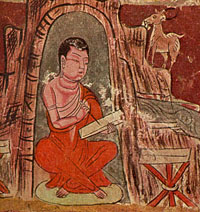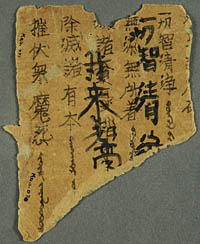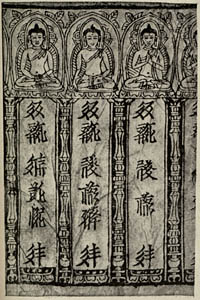Other Followers of Buddhism
on the Silk Road
The Kucheans

|
|
|
A wall-painting in Karashahr. Click on the image to see an enlarged picture. |
|
Kucha was an oasis on the northern Silk Road (see map), populated by people of Indo-European origin. During the time of the Kushana empire, the Kucheans adopted Buddhism, and by the third century CE, Kucha had become one of the most important sites for both Shravakayana and Mahayana Buddhism in Central Asia. Travellers were impressed by the number of monasteries and stupas which had been built by the Kucheans.
The Buddhism of Kucha influenced other states along the northern Silk Road (such as Turfan and Karashahr) and Kuchean Buddhist missionaries travelled further eastward, some of them reaching China. Kumarajiva, one of the greatest of the translators of Buddhism into Chinese, came from Kucha. By the eighth century CE, under pressure from the Chinese and the Turks, Kucha was no longer active as a Buddhist centre.
The Sogdians
The state of Sogdiana existed on the western end of the Silk Road, just north of Gandhara (see map). The Sogdians were successful merchants, often dominating the trade in silk between the third and seventh centuries CE. In their religious life, the Sogdians were above all Zoroastrians, but minority religions including Nestorian Christianity, Manichaeism and Buddhism were tolerated.
Initially, due to influences from the south, the Sogdians adopted Shravakayana Buddhism, and later, in the eighth century under the influence of China, there was a brief flourishing of Mahayana Buddhism. Elements of Buddhism were often combined with Zoroastrianism and with elements of other religions like Manichaeism and Nestorian Christianity. In the eighth century CE, the Sogdians were conquered by the Arabs, and from the middle of the century onwards, Islam became the dominant religion of the area.
The Uighurs

|
|
|
A fragment of Uighur writing. Click on the image to see an enlarged picture. |
|
The Uighur Turks were based in Mongolia when they first came to prominence by defeating neighbouring Turkish tribes in the eighth century CE. After an early Khagan (ruler) converted, the Uighurs became followers of Manichaeism. After the fall of the Khaganate in 840, some Uighurs migrated to the eastern part of the Silk Road and settled in Ganzhou (in modern Gansu). Others travelled further west and settled in the oases the northern Silk Road, such as Kucha and Turfan, which became the Uighur kingdom of Kocho (see map).
Under the influence of the original inhabitants of the northern Silk Road oases, the majority of the Uighurs of Kocho converted to Buddhism. A large Shravakayana canon was translated into Uighur, mainly from the language of Kucha and Karashahr. Other scriptures, these mainly Mahayana, were translated from the Chinese and Tibetan. In 1026 the kingdom of Kocho was conquered by the Tanguts, who continued the Buddhist tradition of the region.
The Tanguts

|
|
|
A Tangut illustrated manuscript. Click on the image to see an enlarged picture. |
|
The Tangut people lived the north-east of the Taklamakan desert (see map). During the eleventh century a Tangut leader achieved independence from China and declared himself emperor. The Tangut state, known to the Chinese as Xi Xia, "Western Xia", was established at the eastern end of the Silk Road, with its western border a little beyond Dunhuang, stretching north to what is now Mongolia and south to the Tibetan plateau.
The Tangut emperors and their subjects followed Mahayana Buddhism, which became the state religion. The Tanguts spoke a language similar to Tibetan, but created their script on the model of Chinese. Much of the Buddhist canon was translated into the Tangut language, most it of from Tibetan sources, probably with the help of Tibetan monks, and some from Chinese. In the twelfth century a complete Tripitaka was translated into Tangut, and printed from wooden blocks.
Buddhism continued to flourish throughout the period of Tangut rule. However, in the thirteenth century the Mongol army of Genghis Khan targeted the Tangut state, and conquered it in 1227. The Mongol ruler of the Tanguts encouraged their conversion to Islam, ending the last period of Buddhism on the Silk Road.